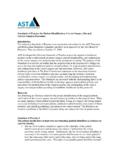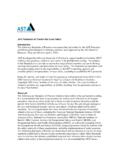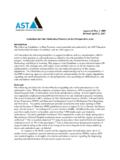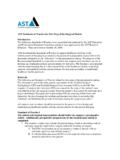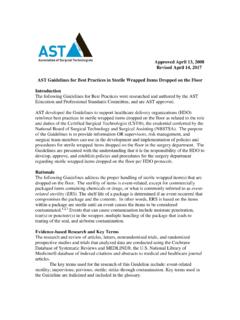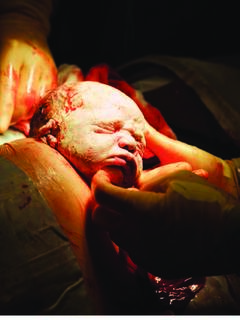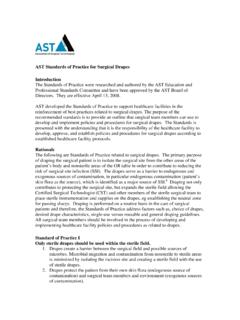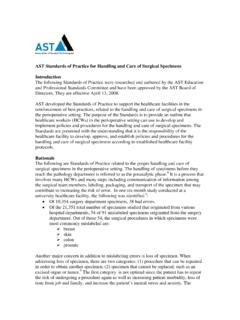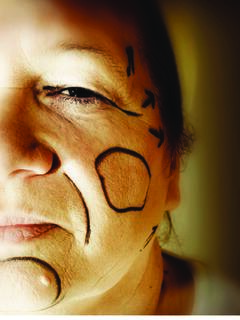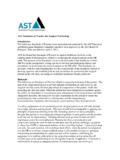Transcription of Standard Decontamination Surgical Instruments
1 Standards of Practice for the Decontamination of Surgical Instruments Introduction The following Standards of Practice were researched and authored by the AST Education and Professional Standards Committee and have been approved by the AST Board of Directors. They are effective April 16, 2009. AST developed the Standards of Practice to support healthcare facilities in the reinforcement of best practices related to the Decontamination of Surgical Instruments in the perioperative setting. The purpose of the Standards is to provide an outline that the Certified Surgical Technologist (CST) and Certified First Assistant (CSFA) can use to develop and implement policies and procedures for the Decontamination of Surgical Instruments . The Standards are presented with the understanding that it is the responsibility of the healthcare facility to develop, approve and establish policies and procedures for cleaning and disinfecting Surgical Instruments according to established healthcare facility protocols.
2 Rationale The following are Standards of Practice related to the proper Decontamination of Surgical Instruments (henceforth, simply referred to as Instruments ) in the perioperative setting. Instruments that are opened on the sterile field, whether used or not used, during the Surgical procedure must be thoroughly decontaminated prior to disinfection and/or sterilization. The terms cleaning and Decontamination are often used synonymously to indicate a physical and chemical process of removal of organic material, soil and debris, and microorganisms from inanimate objects, such as Instruments . The term cleaning frequently, as indicated in the prior sentence, refers to the removal of microorganisms as opposed to killing. However, the Occupational Safety and Health Administration defines Decontamination as, the use of physical or chemical means to remove, inactivate, or destroy blood-borne pathogens on a surface or item to the point where they are no longer capable of transmitting infectious particles and the surface or item is rendered safe for handling, use, or disposal.
3 27 For the remainder of this document, the terms cleaning and Decontamination will be used synonymously, and the OSHA definition will apply to both terms, meaning the process removes, inactivates or destroys microorganisms. When performed properly, cleaning effectively reduces the bioburden in order to prepare the Instruments for disinfection and sterilization. The importance of this step cannot be overemphasized since organic material, soil, and debris can block the disinfectant or sterilizing agent from making complete contact with the surface of the Instruments . Additionally, cleaning allows for the safe handling of the Instruments by healthcare workers (HCWs). Standard of Practice I The cleaning of Instruments should begin during the Surgical procedure to prevent drying of blood, soil and debris on the surface and within lumens.
4 1. The CST in the first scrub role should keep the Instruments free of debris and blood during the Surgical procedure. A. The Instruments should be wiped clean using a sterile, water-moistened sponge. Care must be taken that the sponge is not used on the tissues of the patient. B. Instruments with lumens should be flushed with a sterile, water-filled syringe to remove blood and debris and prevent drying of the gross soil. C. Instruments that may not be used for the remainder of procedure, eg, acetabular reamers used during a total hip arthroplasty, may be placed into a basin containing sterile water to soak. D. Saline must not be used, since the chloride ions can cause pitting and deterioration of the finish on the surface of the Instruments . Standard of Practice II The cleaning of Instruments should continue at the point of use post-procedure, including sorting and disassembly of Instruments , containment and transportation to the Decontamination room.
5 1. Post-procedure, after removal of the sterile gown and gloves, the CST should wear personal protective equipment (PPE) when breaking down the sterile back table. 2. Instruments should never be soaked in saline or sodium hypochlorite (bleach) solution. The chloride ions in both solutions are highly corrosive, causing the breakdown of the finish on Instruments , as well as the metal. A. It is recommended that soaking soiled Instruments begin in the OR at the completion of the procedure. The Instruments can be placed in a basin containing a mixture of sterile water and enzymatic detergent. Refer to the manufacturer s instructions for the correct amounts of sterile water and enzymatic detergent to be mixed. 3. All Instruments that were on the sterile field, whether used or not used, are considered contaminated, and a possible source of microorganisms that could cause an infection in HCWs and patients.
6 A. All Instruments must be properly separated and placed in leakproof, puncture-resistant containers that are marked with a biohazard label to allow easy identification by other HCWs that the contents are contaminated and therefore hazardous. (1) The infection hazard to the Surgical team members is greatest during the handling and separation of contaminated Instruments at the point of use. However, separation is best done in the OR by the CST who is familiar with the back table set up, including location of the sharps container, as well as other sharps such as trocars in order to prevent injury to other Surgical team members. (2) A sponge moistened with water should be used to wipe gross soil and blood from the Instruments that were used during the Surgical procedure. It is recommended not to clean the Instruments within a water-filled basin in order to prevent splashing of the fluid on the floor or other surfaces of the OR (3) Ringed Instruments should be placed in a carrier arranged in single layers or placed on stringers.
7 Box locks should be opened. Assembled Instruments should be taken apart. Heavy Instruments and delicate Instruments , such as microsurgical Instruments should be placed in separate trays. (4) Reusable sharp Instruments with points or edges should be placed in a separate puncture-resistant, closable container. (5) Instruments should be kept wet in the transport container by covering with a water-soaked towel or spray, foam or gel product specifically intended for this purpose. The Instruments should not be transported in the water and enzymatic soaking solution in order to prevent splashing and reduce the weight of the transport container. The enzymatic solution should be properly discarded according to surgery department policy by the CST who is wearing PPE. B. Contaminated Instruments should be contained during transport from the point of use to the Decontamination area.
8 (1) Contaminated Instruments should be handled as little as possible at the point of use and should be immediately contained and transported to the Decontamination area. Immediate containment and transport reduces the risk of Surgical personnel s contact with the contaminated Instruments . (2) Containment should be achieved through the use of some type of container that has been identified to prevent Surgical personnel and other HCWs from contact with the contaminated Instruments and prevention of airborne microorganisms during transport. The type of container to be used depends on the items to be transported. Types of recommended containers include closed carts, bins with lids, rigid sterilization container systems, and impermeable bags that can be used alone or in combination. (3) Rigid sterilization container systems with intact, dry filters and closed valves are an accepted method for the transportation of contaminated Instruments .
9 However, the use of the container for transportation purposes should be confirmed by consulting the manufacturer s instructions. Some manufacturers recommend not using the same container for transporting contaminated Instruments that is also used for the sterilization of the Instruments . (4) The rigid sterilization container system requires no additional covering, unless the external surfaces have been contaminated with blood and/or body fluids. If the container has been handled and touched by a person who has had contact with blood or body fluids, such as the CST, it should be assumed it is contaminated. In this instance, the container should be enclosed in a red biohazard bag, bin with a lid or closed cart. When purchasing a rigid sterilization container system, the healthcare facility should consult the manufacturer s information to confirm if the container can be easily and effectively decontaminated.
10 (5) The external surfaces of bins with lids, closed carts and other containers should be decontaminated after each use with an Environmental Protection Agency (EPA) - registered, intermediate-level disinfectant. The containers should be thoroughly wiped down externally and internally. The use of a cart wash system is recommended for decontaminating closed carts. Additionally, routine cleaning of the case cart wheels should be performed to remove string and other debris to maintain the easy movement of the wheels. Standard of Practice III Cleaning/detergent agents should be selected that will not damage the cleaning equipment and effectively clean Instruments . 1. The chemicals in the cleaning agent(s) should not be corrosive to the cleaning equipment including the ultrasonic cleaner, washer-decontaminator, or washer-sterilizer.
